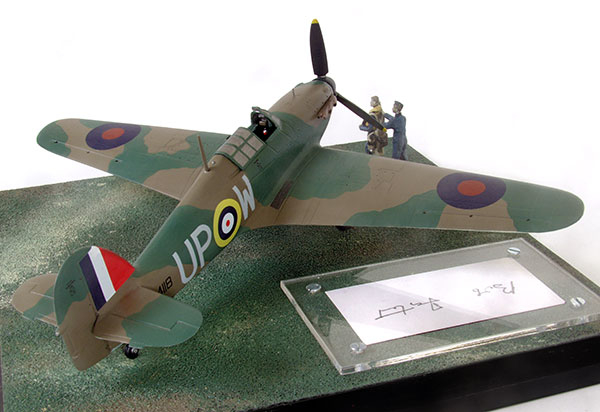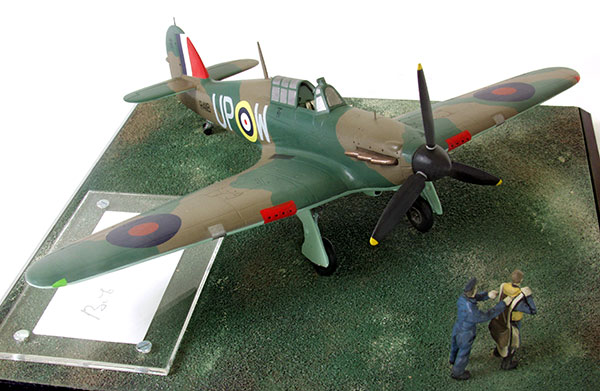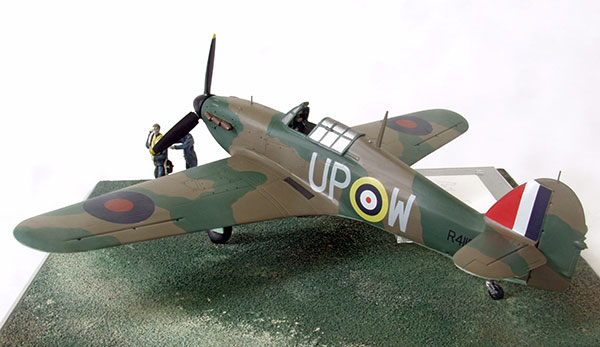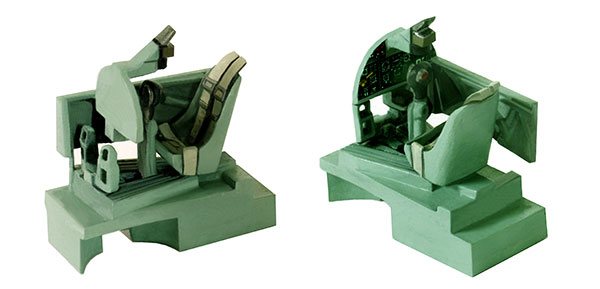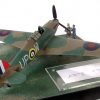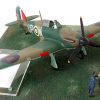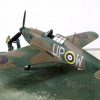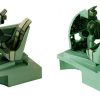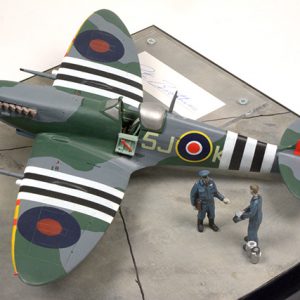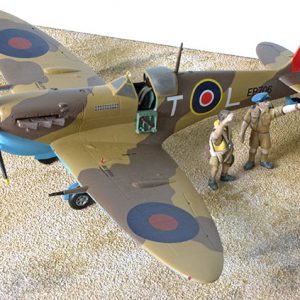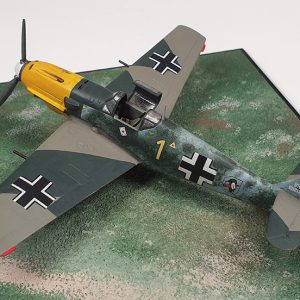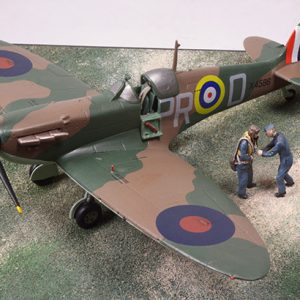Hawker Hurricane Mk I R4118 UP-W 605 Squadron,
Plt Off R W Foster, Croydon, September 1940.
R4118 was one of the second batch of 100 Hurricane Mk Is built at Brockworth by Gloster Aircraft in the early summer of 1940, when the factory was rolling out three aircraft a day; it was delivered new on 17 August 1940 to 605 Squadron – in peacetime the County of Warwick squadron in the Royal Auxiliary Air Force, but absorbed in to the regular RAF on the outbreak of war – while at Drem in Scotland, where it had been based since the end of May following involvement in operations over Dunkirk. On 7 September the Squadron returned south, with Plt.Off. “Bunny” Currant flying R4118 down to Croydon; Bob Foster remembers the airfield as being somewhat chaotic, following a series of attacks, but the squadron, and the aircraft, were in the thick of the fighting later in the month. Foster was flying Hurricane Mk I R4118 on 28 September when he was credited with a share in a “probable” Ju88, and again four days later when he scored a confirmed share in another Ju 88; altogether the aircraft was involved in the shooting down of five targets.
On 22 October R4118 was damaged on its forty-ninth sortie from Croydon and had to be rebuilt, following which it returned to Scotland joining 111 Squadron at Dyce, near Aberdeen in January 1941. Here it was again involved in operations, and while subsequently used in a training role with 56 and 59 Operational Training Units suffered three more major accidents requiring its rebuilding, in one colliding with a lorry on the runway. In January 1943 the aircraft was crated, and despatched to India from Cardiff docks. Intended for more use in a training role it was found not to be needed and remained in its packing case at Bombay until 1947, when it was struck off charge; it was subsequently donated to Banara Hindu University at Varanasi for use as a training aid.
In 1982 Peter Vacher came across the remains of R4118 while cataloguing various Maharajahs’ Rolls-Royces, but it was not until 1996 that he made an offer for it. Following six years of negotiations R4118 returned to England in June 2001 where it was entrusted to Tony Ditheridge’s Hawker Restorations at Milden in Suffolk, making its second “first flight” in December 2003. Since then it’s become a familiar and very welcome sight on the British air show circuit.
A book called ‘Hurricane R4118’ which documents in detail the history of R4118 from entering service to its recovery and restoration to flight by Peter Vacher is available. It is full of photos and well laid out making it an excellent companion for our model. For further information on R4118 and where to obtain a copy of the book go to www.hurricanedisplay.co.uk.
Robert William Foster 80815
Robert William Foster was born in Clapham, South London on May 4th 1920.He worked for Shell and BP after leaving school and on May 1st 1939 he joined the Royal Air Force Volunteer Reserve an an Airman u/t Pilot (748045).
Called up on 2nd September Foster went to No 1 ITW, Cambridge on November 10th and moved to 12 FTS, Grantham on December 30th. After completing his flying training he arrived at 6OTU, Sutton Bridge on June 3rd 1940 to convert to Hurricanes.
Commissioned on the 9th of June Foster was posted to 605 Squadron at Drem on July 6th. In a combat on September 27th Foster damaged a Bf110 but with his own aircraft damaged, he made a forced-landing at Gatwick. On the next day he damaged a Ju88.
On October 7th he claimed a Bf109 destroyed, on the 8th a Ju88 shared, on the 15th a Bf109 probably destroyed and on October 26th and November 8th Bf109s damaged. On March 1941 he damaged an He 111 east of Felixstowe.
In September 1941 Foster was posted away to 55 OTU, Usworth as an instructor. On April 14th 1942 he went to 54 Squadron, Castletown as a Flight Commander.
The squadron was posted overseas in June, embarking in HMT F6 on the 19th for Australia, to take part in the defence against the Japanese. 54 disembarked on September 7th 1942 and was based at Richmond, New South Wales. On January 17th 1943 it moved to Night Cliff, Darwin.
Foster got the squadron’s first victory on February 6th, a Mitsubishi ‘Dinah’. Between March 15th and July 6th 1943 he destroyed four Mitsubishi ‘Bettys’, probably destroyed two others and damaged a ‘Betty’ and a ‘Zeke’. He was awarded the DFC (13.8.43)
On February 2nd 1944 Foster left Australia for the UK. He joined the Air Information Unit on April 29th and went with it to the Continent on July 1st. He was posted to HQ Fighter Command on October 7th 1944, staying there until June 11th 1945, when he went to RAF Bentwaters, initially as Adjutant and later becoming Senior Admin Officer.
Foster was released from the RAF on February 27th 1947 as a Squadron Leader. He served with 613 Fighter Control Unit, RAuxAF from 1948 until March 10th 1957, when the RAuxAF was disbanded.
PO 9.6.40 FO 9.6.40 FL 9.6.42


